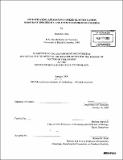| dc.contributor.advisor | Barbara Imperiali. | en_US |
| dc.contributor.author | Chen, Mark M | en_US |
| dc.contributor.other | Massachusetts Institute of Technology. Dept. of Chemistry. | en_US |
| dc.date.accessioned | 2009-08-26T17:11:28Z | |
| dc.date.available | 2009-08-26T17:11:28Z | |
| dc.date.copyright | 2009 | en_US |
| dc.date.issued | 2009 | en_US |
| dc.identifier.uri | http://hdl.handle.net/1721.1/46644 | |
| dc.description | Thesis (Ph. D.)--Massachusetts Institute of Technology, Dept. of Chemistry, 2009. | en_US |
| dc.description | Vita. | en_US |
| dc.description | Includes bibliographical references. | en_US |
| dc.description.abstract | N-linked glycosylation is a ubiquitous form of protein modification whereby a preassembled oligosaccharide is covalently attached the asparagine side chain of an acceptor protein. This process involves numerous enzymes, produces a diverse set of oligosaccharide structures, and results in a variety of structural and functional effects on the glycoprotein. Research discussed in this dissertation applies synthetic organic chemistry to probe this important biological system. To study the effects of N-linked glycosylation on protein folding, a semi-synthetic strategy was developed to access a set of model proteins that were homogeneously glycosylated at several sites of interest. The folding kinetics of this set of glycoproteins were then characterized using stopped-flow fluorescence spectroscopy, which revealed that the presence of the glycan show discrete effects on both the rate of protein folding and unfolding, and that the overall effect is highly specific to the local primary and secondary structure of the glycosylation site. The gram-negative bacterium Campylobacterjejuni was recently discovered to contain a general N-linked glycosylation system with a defined glycan structure and tractable enzymes for heterologous expression including a single subunit oligosaccharyltransferase. To probe the bacterial N-linked glycosylation machinery, a chemo-enzymatic synthesis for each of the glycan intermediates within this pathway was developed, which are impractical to obtain from the host organism. Importantly, chemo-enzymatic allowed for the incorporation of structural modifications for binding-specificity assays and radiolabels for accurate quantification. Access to these substrates allowed us to define the minimum glycosylation consensus sequence for the oligosaccharyltransferase as well as the polyisoprenol specificity of three representative enzymes within the pathway. | en_US |
| dc.description.statementofresponsibility | by Mark M. Chen. | en_US |
| dc.format.extent | 148 p. | en_US |
| dc.language.iso | eng | en_US |
| dc.publisher | Massachusetts Institute of Technology | en_US |
| dc.rights | M.I.T. theses are protected by
copyright. They may be viewed from this source for any purpose, but
reproduction or distribution in any format is prohibited without written
permission. See provided URL for inquiries about permission. | en_US |
| dc.rights.uri | http://dspace.mit.edu/handle/1721.1/7582 | en_US |
| dc.subject | Chemistry. | en_US |
| dc.title | Investigating asparagine-linked glycosylation substrate : specificity and effects on protein folding | en_US |
| dc.type | Thesis | en_US |
| dc.description.degree | Ph.D. | en_US |
| dc.contributor.department | Massachusetts Institute of Technology. Department of Chemistry | |
| dc.identifier.oclc | 426526408 | en_US |
